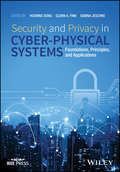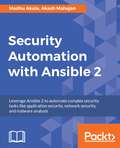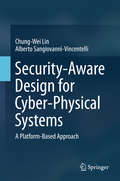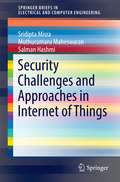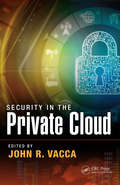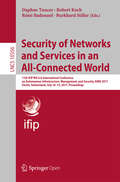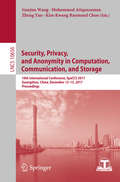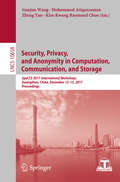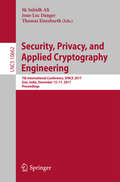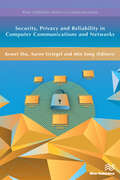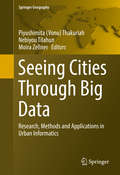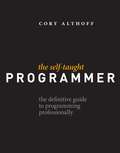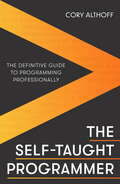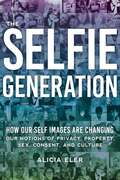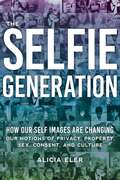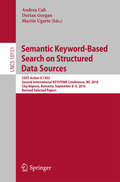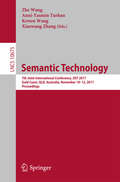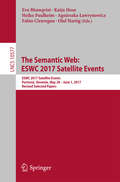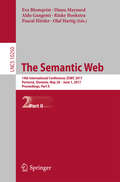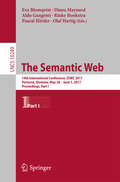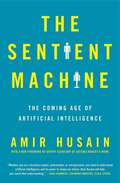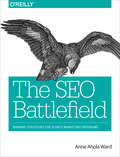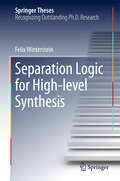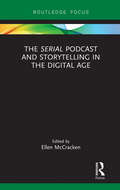- Table View
- List View
Security and Privacy in Cyber-Physical Systems: Foundations, Principles, and Applications
by Houbing Song Glenn A. Fink Sabina JeschkeWritten by a team of experts at the forefront of the cyber-physical systems (CPS) revolution, this book provides an in-depth look at security and privacy, two of the most critical challenges facing both the CPS research and development community and ICT professionals. It explores, in depth, the key technical, social, and legal issues at stake, and it provides readers with the information they need to advance research and development in this exciting area. Cyber-physical systems (CPS) are engineered systems that are built from, and depend upon the seamless integration of computational algorithms and physical components. Advances in CPS will enable capability, adaptability, scalability, resiliency, safety, security, and usability far in excess of what today’s simple embedded systems can provide. Just as the Internet revolutionized the way we interact with information, CPS technology has already begun to transform the way people interact with engineered systems. In the years ahead, smart CPS will drive innovation and competition across industry sectors, from agriculture, energy, and transportation, to architecture, healthcare, and manufacturing. A priceless source of practical information and inspiration, Security and Privacy in Cyber-Physical Systems: Foundations, Principles and Applications is certain to have a profound impact on ongoing R&D and education at the confluence of security, privacy, and CPS.
Security Automation with Ansible 2: Leverage Ansible 2 to automate complex security tasks like application security, network security, and malware analysis
by Madhu Akula Akash MahajanAutomate security-related tasks in a structured, modular fashion using the best open source automation tool available About This Book • Leverage the agentless, push-based power of Ansible 2 to automate security tasks • Learn to write playbooks that apply security to any part of your system • This recipe-based guide will teach you to use Ansible 2 for various use cases such as fraud detection, network security, governance, and more Who This Book Is For If you are a system administrator or a DevOps engineer with responsibility for finding loop holes in your system or application, then this book is for you. It's also useful for security consultants looking to automate their infrastructure's security model. What You Will Learn • Use Ansible playbooks, roles, modules, and templating to build generic, testable playbooks • Manage Linux and Windows hosts remotely in a repeatable and predictable manner • See how to perform security patch management, and security hardening with scheduling and automation • Set up AWS Lambda for a serverless automated defense • Run continuous security scans against your hosts and automatically fix and harden the gaps • Extend Ansible to write your custom modules and use them as part of your already existing security automation programs • Perform automation security audit checks for applications using Ansible • Manage secrets in Ansible using Ansible Vault In Detail Security automation is one of the most interesting skills to have nowadays. Ansible allows you to write automation procedures once and use them across your entire infrastructure. This book will teach you the best way to use Ansible for seemingly complex tasks by using the various building blocks available and creating solutions that are easy to teach others, store for later, perform version control on, and repeat. We'll start by covering various popular modules and writing simple playbooks to showcase those modules. You'll see how this can be applied over a variety of platforms and operating systems, whether they are Windows/Linux bare metal servers or containers on a cloud platform. Once the bare bones automation is in place, you'll learn how to leverage tools such as Ansible Tower or even Jenkins to create scheduled repeatable processes around security patching, security hardening, compliance reports, monitoring of systems, and so on. Moving on, you'll delve into useful security automation techniques and approaches, and learn how to extend Ansible for enhanced security. While on the way, we will tackle topics like how to manage secrets, how to manage all the playbooks that we will create and how to enable collaboration using Ansible Galaxy. In the final stretch, we'll tackle how to extend the modules of Ansible for our use, and do all the previous tasks in a programmatic manner to get even more powerful automation frameworks and rigs. Style and approach This comprehensive guide will teach you to manage Linux and Windows hosts remotely in a repeatable and predictable manner. The book takes an in-depth approach and helps you understand how to set up complicated stacks of software with codified and easy-to-share best practices.
Security-Aware Design for Cyber-Physical Systems
by Chung-Wei Lin Alberto Sangiovanni-VincentelliAddressing the rising security issues during the design stages of cyber-physical systems, this book develops a systematic approach to address security at early design stages together with all other design constraints. Cyber-attacks become more threatening as systems are becoming more connected with the surrounding environment, infrastructures, and other systems. Security mechanisms can be designed to protect against attacks and meet security requirements, but there are many challenges of applying security mechanisms to cyber-physical systems including open environments, limited resources, strict timing requirements, and large number of devices. Designed for researchers and professionals, this book is valuable for individuals working in network systems, security mechanisms, and system design. It is also suitable for advanced-level students of computer science.
Security Challenges and Approaches in Internet of Things
by Sridipta Misra Muthucumaru Maheswaran Salman HashmiThis book provides a comprehensive survey of the security and privacy research advancements in Internet of Things (IoT). The book lays the context for the discussion by introducing a system model for IoT. Since IoT is very varied and has been introduced in many different contexts, the system model introduced plays a crucial role in integrating the concepts into a coherent framework. After the system model, the book introduces the vulnerable features of the IoT. By providing a comprehensive discussion of the vulnerable features, the book highlights the problem areas of IoT that should be studied concerning security and privacy. Using the vulnerable features as a motivation, the book presents a vast survey of existing security and privacy approaches for IoT. The survey is a good way for the reader to pick up interesting directions of research that have already been explored and also hints at directions that could take additional investigation. Finally, the book presents four case studies that provide a detailed view of how some of the security and privacy concerns are addressed in specific problem areas.
Security in the Private Cloud
by John R. VaccaThis comprehensive handbook serves as a professional reference and practitioner’s guide to today’s most complete and concise view of private cloud security. It explores practical solutions to a wide range of private cloud computing security issues. The knowledge imparted will enable readers to determine whether the private cloud security solution is appropriate for their organization from a business and technical perspective, to select the appropriate cloud security model, and to plan and implement a cloud security adoption and migration strategy.
Security of Networks and Services in an All-Connected World: 11th IFIP WG 6.6 International Conference on Autonomous Infrastructure, Management, and Security, AIMS 2017, Zurich, Switzerland, July 10-13, 2017, Proceedings (Lecture Notes in Computer Science #10356)
by Burkhard Stiller Rémi Badonnel Robert Koch Daphne TuncerThis book is open access under a CC BY 4. 0 license. This book constitutes the refereed proceedings of the 11th IFIP WG 6. 6 International Conference on Autonomous Infrastructure, Management, and Security, AIMS 2017, held in Zurich, Switzerland, in July 2017. The 8 full papers presented together with 11 short papers were carefully reviewed and selected from 24 submissions. The papers are organized in the following topical sections: security management; management of cloud environments and services, evaluation and experimental study of rich network services; security, intrusion detection, and configuration; autonomic and self-management solutions; and methods for the protection of infrastructure.
Security, Privacy, and Anonymity in Computation, Communication, and Storage
by Guojun Wang Mohammed Atiquzzaman Zheng Yan Kim-Kwang Raymond ChooThis book constitutes the refereed proceedings of 11 symposia and workshops held at the 10th International Conference on Security, Privacy and Anonymity in Computation, Communication, and Storage, SpaCCS 2017, held in Guangzhou, China, in December 2017. The total of 75 papers presented in this volume was carefully reviewed and selected from a total of 190 submissions to all workshops: UbiSafe 2017: The 9th IEEE International Symposium on UbiSafe Computing ISSR 2017: The 9th IEEE International Workshop on Security in e-Science and e-Research TrustData 2017: The 8th International Workshop on Trust, Security and Privacy for Big Data TSP 2017: The 7th International Symposium on Trust, Security and Privacy for Emerging Applications SPIoT 2017: The 6th International Symposium on Security and Privacy on Internet of Things NOPE 2017: The 5th International Workshop on Network Optimization and Performance Evaluation DependSys 2017: The Third International Symposium on Dependability in Sensor, Cloud, and Big Data Systems and Applications SCS 2017: The Third International Symposium on Sensor-Cloud Systems WCSSC 2017: The Second International Workshop on Cloud Storage Service and Computing MSCF 2017: The First International Symposium on Multimedia Security and Digital Forensics SPBD 2017: The 2017 International Symposium on Big Data and Machine Learning in Information Security, Privacy and Anonymity
Security, Privacy, and Anonymity in Computation, Communication, and Storage
by Guojun Wang Mohammed Atiquzzaman Zheng Yan Kim-Kwang Raymond ChooThis book constitutes the refereed proceedings of 11 symposia and workshops held at the 10th International Conference on Security, Privacy and Anonymity in Computation, Communication, and Storage, SpaCCS 2017, held in Guangzhou, China, in December 2017. The total of 75 papers presented in this volume was carefully reviewed and selected from a total of 190 submissions to all workshops: UbiSafe 2017: The 9th IEEE International Symposium on UbiSafe Computing ISSR 2017: The 9th IEEE International Workshop on Security in e-Science and e-Research TrustData 2017: The 8th International Workshop on Trust, Security and Privacy for Big Data TSP 2017: The 7th International Symposium on Trust, Security and Privacy for Emerging Applications SPIoT 2017: The 6th International Symposium on Security and Privacy on Internet of Things NOPE 2017: The 5th International Workshop on Network Optimization and Performance Evaluation DependSys 2017: The Third International Symposium on Dependability in Sensor, Cloud, and Big Data Systems and Applications SCS 2017: The Third International Symposium on Sensor-Cloud Systems WCSSC 2017: The Second International Workshop on Cloud Storage Service and Computing MSCF 2017: The First International Symposium on Multimedia Security and Digital Forensics SPBD 2017: The 2017 International Symposium on Big Data and Machine Learning in Information Security, Privacy and Anonymity
Security, Privacy, and Applied Cryptography Engineering: 7th International Conference, SPACE 2017, Goa, India, December 13-17, 2017, Proceedings (Lecture Notes in Computer Science #10662)
by Sk Subidh Ali, Jean-Luc Danger and Thomas EisenbarthThis book constitutes the refereed proceedings of the 7th International Conference on Security, Privacy, and Applied Cryptography Engineering, SPACE 2017, held in Goa, India, in December 2017. The 13 revised full papers presented together with 1 short paper, 7 invited talks, and 4 tutorials were carefully reviewed and selected from 49 initial submissions. This annual event is devoted to various aspects of security, privacy, applied cryptography, and cryptographic engineering. This is indeed a very challenging field, requiring the expertise from diverse domains, ranging from mathematics to solid-state circuit design.
Security, Privacy and Reliability in Computer Communications and Networks
by Kewei Sha Aaron Striegel Min SongFuture communication networks aim to build an intelligent and efficient living environment by connecting a variety of heterogeneous networks to fulfill complicated tasks. These communication networks bring significant challenges in building secure and reliable communication networks to address the numerous threat and privacy concerns. New research technologies are essential to preserve privacy, prevent attacks, and achieve the requisite reliability. Security, Privacy and Reliability in Computer Communications and Networks studies and presents recent advances reflecting the state-of-the-art research achievements in novel cryptographic algorithm design, intrusion detection, privacy preserving techniques and reliable routing protocols. Technical topics discussed in the book include: Vulnerabilities and Intrusion DetectionCryptographic Algorithms and EvaluationPrivacyReliable Routing ProtocolsThis book is ideal for personnel in computer communication and networking industries as well as academic staff and collegial, master, Ph.D. students in computer science, computer engineering, cyber security, information insurance and telecommunication systems.
See Ya Later: The World According to Arron Crascall
by Arron CrascallAlright guys? It's me, Arron. Or as some people call me, 'that guy with the phone, the skinny jeans and the really fat head'.In a world that seems to be freefalling without a parachute towards utter chaos, I'm here to remind you that when life gives you lemons, make lemonade. No, in fact, when life gives you lemons, make a fool out of yourself in the lemonade aisle.*Because there's more to life than Brexit, Bake Off and banging on about being vegan. Yes, with this book - which is my take on the world - you will learn how to survive a proper lads' holiday, become a master in the art of takeaway ordering and find out about the pitfalls of seriously inappropriate tattoos.So do yourself a favour: turn off the news, cancel that juice cleanse, open your eyes to the brilliant, hilarious world we live in and most importantly . . . buy this book.SEE YA LATER! Arron x*Actually, don't do exactly that, that's my thing.
Seeing Cities Through Big Data
by Piyushimita Vonu Thakuriah Nebiyou Tilahun Moira ZellnerThis book introduces the latest thinking on the use of Big Data in the context of urban systems, including research and insights on human behavior, urban dynamics, resource use, sustainability and spatial disparities, where it promises improved planning, management and governance in the urban sectors (e. g. , transportation, energy, smart cities, crime, housing, urban and regional economies, public health, public engagement, urban governance and political systems), as well as Big Data's utility in decision-making, and development of indicators to monitor economic and social activity, and for urban sustainability, transparency, livability, social inclusion, place-making, accessibility and resilience.
The Self-Taught Programmer: The Definitive Guide to Programming Professionally, 1st Edition
by Cory AlthoffI am a self-taught programmer. After a year of self-study, I learned to program well enough to land a job as a software engineer II at eBay. Once I got there, I realized I was severely under-prepared. I was overwhelmed by the amount of things I needed to know but hadn't learned yet. My journey learning to program, and my experience at my first job as a software engineer were the inspiration for this book. <P><P>This book is not just about learning to program; although you will learn to code. If you want to program professionally, it is not enough to learn to code; that is why, in addition to helping you learn to program, I also cover the rest of the things you need to know to program professionally that classes and books don't teach you. "The Self-taught Programmer" is a roadmap, a guide to take you from writing your first Python program, to passing your first technical interview. I divided the book into five sections: <P><P> 1. Learn to program in Python 3 and build your first program. </br> 2. Learn Object-oriented programming and create a powerful Python program to get you hooked. </br> 3. Learn to use tools like Git, Bash, regular expressions and databases. Then use your new coding skills to build a web scraper. </br> 4. Study Computer Science fundamentals like data structures and algorithms.</br> 5. Finish with tips for working with a team and landing a programming job. <P><P>You CAN learn to program professionally. The path is there. Will you take it?
The Self-taught Programmer: The Definitive Guide to Programming Professionally
by Cory Althoff'One of the best software design books of all time' - BookAuthorityCory Althoff is a self-taught programmer. After a year of self-study, he learned to program well enough to land a job as a software engineer II at eBay. But once he got there, he realised he was severely under-prepared. He was overwhelmed by the amount of things he needed to know but hadn't learned. His journey learning to program, and his experience in first software engineering job were the inspiration for this book. This book is not just about learning to program, although you will learn to code. If you want to program professionally, it is not enough to learn to code; that is why, in addition to helping you learn to program, Althoff also cover the rest of the things you need to know to program professionally that classes and books don't teach you. The Self-taught Programmer is a roadmap, a guide to take you from writing your first Python program to passing your first technical interview. The book is divided into five sections: 1. Learn to program in Python 3 and build your first program. 2. Learn object-oriented programming and create a powerful Python program to get you hooked. 3. Learn to use tools like Git, Bash and regular expressions. Then use your new coding skills to build a web scraper. 4. Study computer science fundamentals like data structures and algorithms. 5. Finish with best coding practices, tips for working with a team and advice on landing a programming job.You can learn to program professionally. The path is there. Will you take it?From the authorI spent one year writing The Self-Taught Programmer. It was an exciting and rewarding experience. I treated my book like a software project. After I finished writing it, I created a program to pick out all of the code examples from the book and execute them in Python to make sure all 300+ examples worked properly. Then I wrote software to add line numbers and color to every code example. Finally, I had a group of 200 new programmers 'beta read' the book to identify poorly explained concepts and look for any errors my program missed. I hope you learn as much reading my book as I did writing it. Best of luck with your programming!
The Selfie Generation: How Our Self-Images Are Changing Our Notions of Privacy, Sex, Consent, and Culture
by Alicia ElerWhether it's Kim Kardashian uploading picture after picture to Instagram or your roommate posting a mid-vacation shot to Facebook, selfies receive mixed reactions. But are selfies more than, as many critics lament, a symptom of a self-absorbed generation? Millennial Alicia Eler's The Selfie Generation is the first book to delve fully into this ubiquitous and much-maligned part of social media, including why people take them in the first place and the ways they can change how we see ourselves. Eler argues that selfies are just one facet of how we can use digital media to create a personal brand in the modern age. More than just a picture, they are an important part of how we live today. Eler examines all aspects of selfies, online social networks, and the generation that has grown up with them. She looks at how the boundaries between people’s physical and digital lives have blurred with social media; she explores questions of privacy, consent, ownership, and authenticity; and she points out important issues of sexism and double standards wherein women are encouraged to take them but then become subject to criticism and judgment. Alicia discusses the selfie as a paradox-both an image with potential for self-empowerment, yet also a symbol of complacency within surveillance culture The Selfie Generation explores just how much social media has changed the ways that people connect, communicate, and present themselves to the world.
The Selfie Generation: How Our Self-Images Are Changing Our Notions of Privacy, Sex, Consent, and Culture
by Alicia Eler<p>Whether it's Kim Kardashian uploading picture after picture to Instagram or your roommate posting a mid-vacation shot to Facebook, selfies receive mixed reactions. But are selfies more than, as many critics lament, a symptom of a self-absorbed generation? <p>Millennial Alicia Eler's The Selfie Generation is the first book to delve fully into this ubiquitous and much-maligned part of social media, including why people take them in the first place and the ways they can change how we see ourselves. Eler argues that selfies are just one facet of how we can use digital media to create a personal brand in the modern age. More than just a picture, they are an important part of how we live today. <p>Eler examines all aspects of selfies, online social networks, and the generation that has grown up with them. She looks at how the boundaries between people’s physical and digital lives have blurred with social media; she explores questions of privacy, consent, ownership, and authenticity; and she points out important issues of sexism and double standards wherein women are encouraged to take them but then become subject to criticism and judgment. Alicia discusses the selfie as a paradox—both an image with potential for self-empowerment, yet also a symbol of complacency within surveillance culture The Selfie Generation explores just how much social media has changed the ways that people connect, communicate, and present themselves to the world.</p>
Semantic Keyword-Based Search on Structured Data Sources: COST Action IC1302 Second International KEYSTONE Conference, IKC 2016, Cluj-Napoca, Romania, September 8–9, 2016, Revised Selected Papers (Lecture Notes in Computer Science #10151)
by Andrea Calì Dorian Gorgan Martín UgarteThis book constitutes the thoroughly refereed post-conference proceedings of the Second COST Action IC1302 International KEYSTONE Conference on Semantic Keyword-Based Search on Structured Data Sources, IKC 2016, held in Cluj-Napoca, Romania, in September 2016. The 15 revised full papers and 2 invited papers are reviewed and selected from 18 initial submissions and cover the areas of keyword extraction, natural language searches, graph databases, information retrieval techniques for keyword search and document retrieval.
Semantic Technology: 7th Joint International Conference, JIST 2017, Gold Coast, QLD, Australia, November 10-12, 2017, Proceedings (Lecture Notes in Computer Science #10675)
by Zhe Wang Anni-Yasmin Turhan Kewen Wang Xiaowang ZhangThis book constitutes the thoroughly refereed proceedings of the 7th Joint International Semantic Technology Conference, JIST 2017, held in Goldcoast, QLD, Australia, in November 2017. The 19 full papers and 4 short papers presented were carefully reviewed and selected from 37 submissions. They present applications of semantic technologies, theoretical results, new algorithms and tools to facilitate the adoption of semantic technologies and are organized in topical sections on ontology and data management; ontology reasoning; linked data and query; information retrieval and knowledge discovery; knowledge graphs; and applications of semantic technologies.
The Semantic Web: ESWC 2017 Satellite Events, Portorož, Slovenia, May 28 – June 1, 2017, Revised Selected Papers (Lecture Notes in Computer Science #10577)
by Agnieszka Ławrynowicz Heiko Paulheim Eva Blomqvist Olaf Hartig Katja Hose Fabio CiravegnaThis book constitutes the thoroughly refereed post-conference proceedings of the Satellite Events of the 14th European Conference on the Semantic Web, ESWC 2017, held in Portoroz, Slovenia, in May/June 2017. The volume contains 8 poster and 24 demonstration papers, selected from 105 submissions. Additionally, this book includes a selection of 13 best workshop papers. The papers cover various aspects of the semantic web.
The Semantic Web: 14th International Conference, ESWC 2017, Portorož, Slovenia, May 28 – June 1, 2017, Proceedings, Part II (Lecture Notes in Computer Science #10250)
by Eva Blomqvist Diana Maynard Aldo Gangemi Rinke Hoekstra Pascal Hitzler Olaf HartigThe two volumes LNCS 10249 and 10250 constitute the refereed proceedings of the 14th International Semantic Web Conference, ESWC 2017, held in Portorož, Slovenia.The 51 revised full papers presented were carefully reviewed and selected from 183 submissions. In addition, 10 PhD papers are included, selected out of 14 submissions. The papers are organized in the following tracks: semantic data management, big data, and scalability; linked data; machine learning; mobile web, sensors, and semantic streams; natural language processing and information retrieval; vocabularies, schemas, and ontologies; reasoning; social web and web science; semantic web and transparency; in use and industrial track; and PhD symposium.
The Semantic Web: 14th International Conference, ESWC 2017, Portorož, Slovenia, May 28 – June 1, 2017, Proceedings, Part I (Lecture Notes in Computer Science #10249)
by Eva Blomqvist Diana Maynard Aldo Gangemi Rinke Hoekstra Pascal Hitzler Olaf HartigThe two volumes LNCS 10249 and 10250 constitute the refereed proceedings of the 14th International Semantic Web Conference, ESWC 2017, held in Portorož, Slovenia.The 51 revised full papers presented were carefully reviewed and selected from 183 submissions. In addition, 10 PhD papers are included, selected out of 14 submissions. The papers are organized in the following tracks: semantic data management, big data, and scalability; linked data; machine learning; mobile web, sensors, and semantic streams; natural language processing and information retrieval; vocabularies, schemas, and ontologies; reasoning; social web and web science; semantic web and transparency; in use and industrial track; and PhD symposium.The paper 'Linked Data Notifications: A Resource-Centric Communication Protocol' is published open access under a CC BY 4.0 license at link.springer.com.
The Sentient Machine: The Coming Age of Artificial Intelligence
by Amir Husain&“A must-read for anyone looking to understand how artificial intelligence is poised to transform human society and life.&” —Paul Scharre, Author of Four Battlegrounds: Power in the Age of Artificial IntelligenceThe future is now. Acclaimed technologist and inventor Amir Husain explains how we can live amidst the coming age of sentient machines and artificial intelligence—and not only survive, but thrive.Artificial &“machine&” intelligence is playing an ever-greater role in our society. We are already using cruise control in our cars, automatic checkout at the drugstore, and are unable to live without our smartphones. The discussion around AI is polarized; people think either machines will solve all problems for everyone, or they will lead us down a dark, dystopian path into total human irrelevance. Regardless of what you believe, the idea that we might bring forth intelligent creation can be intrinsically frightening. But what if our greatest role as humans so far is that of creators?Amir Husain, a brilliant inventor and computer scientist, argues that we are on the cusp of writing our next, and greatest, creation myth. It is the dawn of a new form of intellectual diversity, one that we need to embrace in order to advance the state of the art in many critical fields, including security, resource management, finance, and energy. &“In The Sentient Machine, Husain prepares us for a brighter future; not with hyperbole about right and wrong, but with serious arguments about risk and potential&” (Dr. Greg Hyslop, Chief Technology Officer, The Boeing Company). He addresses broad existential questions surrounding the coming of AI: Why are we valuable? What can we create in this world? How are we intelligent? What constitutes progress for us? And how might we fail to progress? Husain boils down complex computer science and AI concepts into clear, plainspoken language and draws from a wide variety of cultural and historical references to illustrate his points. Ultimately, Husain challenges many of our societal norms and upends assumptions we hold about &“the good life.&”
The SEO Battlefield: Winning Strategies for Search Marketing Programs
by Anne Ahola WardWelcome to the battlefield. Every day, companies ranging from startups to enterprises fight to achieve high search rankings, knowing that previous success can quickly vanish. With this practical guide, you’ll learn how to put search engine optimization (SEO) methodology into practice, including the research, data analysis, and constant experimentation required to build an SEO program specific to your organization that can help you improve search results.Running a successful SEO program requires a team with a mix of skills, including marketing, analytics, website development, and automation. Author Anne Ahola Ward walks marketers and developers through SEO essentials and provides real-world case studies of successful and not-so-successful SEO programs. You’ll quickly understand why this is both an exciting and critical time to adopt SEO in your organization.Perform keyword goals and research, and spot search trendsUnderstand the motivation and creativity of the SEO mindsetRun a campaign to generate traffic and measure the resultsUse mobile and platform-agnostic strategies for search growthDemonstrate the value of your search marketing effortsInclude web development in your SEO program—everything from quick updates to UX/UI strategyLearn the sweetest way to run and report on an search program
Separation Logic for High-level Synthesis
by Felix WintersteinThis book presents novel compiler techniques, which combine a rigorous mathematical framework, novel program analyses and digital hardware design to advance current high-level synthesis tools and extend their scope beyond the industrial 'state of the art'. Implementing computation on customised digital hardware plays an increasingly important role in the quest for energy-efficient high-performance computing. Field-programmable gate arrays (FPGAs) gain efficiency by encoding the computing task into the chip's physical circuitry and are gaining rapidly increasing importance in the processor market, especially after recent announcements of large-scale deployments in the data centre. This is driving, more than ever, the demand for higher design entry abstraction levels, such as the automatic circuit synthesis from high-level languages (high-level synthesis). The techniques in this book apply formal reasoning to high-level synthesis in the context of demonstrably practical applications.
The Serial Podcast and Storytelling in the Digital Age (Routledge Focus on Digital Media and Culture)
by Ellen McCrackenThis volume analyzes the Serial podcast, situating it in the trajectory of other popular crime narratives and contemporary cultural theory. Contributors focus on topics such as the ethics of the use of fiction techniques in investigative journalism, the epistemological overlay of postmodern indeterminacy, and the audience’s prolific activity in social media, examining the competing narrative strategies of the narrators, characters, and the audience. Other topics considered include the multiplication of narratives and the longing for closure, how our minds work as we experience true crime narratives, and what critical race theory can teach us about the program’s strategies.
